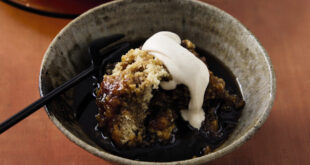
Fresh herbs can make a meal. They add a touch of sophistication, a pop of colour and an explosion of taste and fragrance. They can be a bit expensive to buy at certain times, but add them to your garden and you need never be without them!
Here’s a quick guide to some easy-to-grow herbs and how to and when to use them.
Parsley – Parsley is rich in nutrients and a great way to sneak “greens” into the family diet. It is commonly used as a garnish or finely chopped in soups, sauces, meat dishes, mashed potatoes and carrots, in stuffing and in salads. In fact it can be sprinkled on virtually anything – okay, maybe not ice cream! It is easy to grow from seedlings. Nipping out the tops will encourage growth.
Mint – Mint is so rampant that it should be contained in pot or its own confined spot in the garden. It is best known as the main ingredient of mint sauce used with roast lamb. As well it adds a uniquely fresh flavour to boiled potatoes and peas.
A reader suggests that if you add fresh mint and a slice of lemon to a cool jug of water, you will be able to delete fizzy drinks from your weekly shopping list!
Thyme – The most popular varieties are common thyme and lemon thyme. It is used in soups, stuffing, meat loaves, roasted meats, casseroles, stews, egg dishes, salads, breads, sauces, spreads and vegetables. Cutting the bush back in winter will encourage new growth.
Basil – An ideal pot plant for the patio garden or a warm sunny spot on the kitchen windowsill as basil needs warmth and regular watering. The most common variety is sweet basil. When cooking, think basil and tomato: it is ideal for tomato soups, tomato salads, tomato sauce, tomato paste, tomato this and tomato that – so much so that it is often referred to as the tomato herb.
Allie from Nelson has this tip. “When you are harvesting basil, as well as making pesto, freeze some leaves in very small plastic bags. They will last all year in the freezer. Just take one out, crumble it (while it is still crunchy) into pasta dishes. It keeps all the fragrance and flavour of fresh basil.” This applies to many other herbs as well, including parsley, mint, and thyme.
A reader from Masterton says, “A friend gave me some basil mint with the caution not to let it spread out of its container. To stop it spreading I trim it weekly and make a batch of basil mint pesto. Basil is a real oily rag plant – so good to have it providing us with such delicious pesto.”
If you want a good pesto recipe, have a look at the one on the oily rag website by Luigi – he describes it as “Perfecto!”
Rosemary – A strong smelling evergreen shrub, the upright varieties are best for cooking. Picking out the tips will keep young plants bushy and new growth can be encouraged by cutting older bushes back to half that year’s growth – at the end of the summer. It is commonly used with roast meats, especially lamb but also chicken or game.
Impress your friends by using rosemary spikes as the skewer for meat and vegetable kebabs, or throw some sprigs on the hot coals to add aroma to BBQ meat. A few sprigs of rosemary placed in the roasting dish with a medley of vegetables and garlic will bring out wonderful flavours and turn a simple serving of roast vegetables into fine oily rag cuisine.
Oregano – There are several varieties of oregano but Greek oregano is the one generally preferred for cooking. Like rosemary and thyme it needs full sun and soil that’s not too fertile. It is also suited to growing in pots. The plant will last for many years, but does need to be nipped back to encourage new growth. It is frequently used in Italian cooking and combined with basil in tomato dishes to create a distinctive Italian taste.
Here’s a quick check list to see if you have the right herb for the dish.
Egg & Chicken Dishes – Tarragon, chervil, basil, or chives.
Fish – Marjoram, thyme, basil, sage.
Ground Beef – Basil, marjoram, thyme, parsley.
Lamb – Marjoram, rosemary, mint.
Pork – Sage, basil.
Poultry stuffing – Marjoram, thyme, basil, sage.
Vegetables – Marjoram, basil, chervil, rosemary.
By Frank and Dr Muriel Newman. Read more here.
Please send in your oily rag questions and tips to share with others by visiting our website (www.oilyrag.co.nz) or by writing to Living off the Smell of an Oily Rag, PO Box 984, Whangarei.









Join the Discussion
Type out your comment here:
You must be logged in to post a comment.